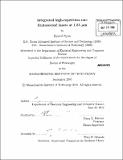| dc.contributor.advisor | Franz X. Kärtner. | en_US |
| dc.contributor.author | Byun, Hyunil | en_US |
| dc.contributor.other | Massachusetts Institute of Technology. Dept. of Electrical Engineering and Computer Science. | en_US |
| dc.date.accessioned | 2011-04-25T15:50:32Z | |
| dc.date.available | 2011-04-25T15:50:32Z | |
| dc.date.copyright | 2010 | en_US |
| dc.date.issued | 2010 | en_US |
| dc.identifier.uri | http://hdl.handle.net/1721.1/62384 | |
| dc.description | Thesis (Ph. D.)--Massachusetts Institute of Technology, Dept. of Electrical Engineering and Computer Science, 2010. | en_US |
| dc.description | In title on title-page, [mu] appears as a Greek symbol. Cataloged from PDF version of thesis. | en_US |
| dc.description | Includes bibliographical references (p. 191-201). | en_US |
| dc.description.abstract | Performance of state-of-the-art, electronic analog-to-digital converters is currently limited by the 100-fs aperture jitter. However, optical sampling can overcome the jitter limit by using femtosecond lasers that have jitter as low as 100 as, which is a three orders of magnitude improvement when compared to electronics. Currently, most of these lasers exist as bulk or fiber lasers. While such configurations can provide flexibility in order to tailor the behavior of the lasers to specific needs, they are usually as expensive as $10,000 to $100,000 and require precisely adjustable mounts and high-quality optical components. To realize the possibility of femtosecond lasers replacing current electronics for unprecedented performance in the future, these lasers must be as compact, robust, and affordable as electronic circuits. A monolithically integrated mode-locked laser can lower the cost of building such femtosecond lasers and, at the same time, make them less vulnerable to environmental perturbation. This can be achieved by mass-producing them with less expensive materials such as silicon, silicon oxide, or compatible materials. Since all necessary optical components are integrated monolithically on a silicon substrate, bulky and expensive high-precision discrete components can be excluded. The goal of this thesis is the development of femtosecond lasers that can overcome the limit of electronics and potentially replace them. Possible approaches and current achievements are discussed towards this goal. | en_US |
| dc.description.statementofresponsibility | by Hyunil Byun. | en_US |
| dc.format.extent | 201 p. | en_US |
| dc.language.iso | eng | en_US |
| dc.publisher | Massachusetts Institute of Technology | en_US |
| dc.rights | M.I.T. theses are protected by
copyright. They may be viewed from this source for any purpose, but
reproduction or distribution in any format is prohibited without written
permission. See provided URL for inquiries about permission. | en_US |
| dc.rights.uri | http://dspace.mit.edu/handle/1721.1/7582 | en_US |
| dc.subject | Electrical Engineering and Computer Science. | en_US |
| dc.title | Integrated high-repetition-rate femtosecond lasers at 1.55 [mu]m | en_US |
| dc.type | Thesis | en_US |
| dc.description.degree | Ph.D. | en_US |
| dc.contributor.department | Massachusetts Institute of Technology. Department of Electrical Engineering and Computer Science | |
| dc.identifier.oclc | 709777304 | en_US |
